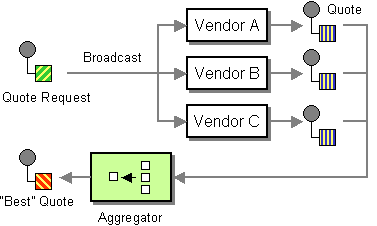Since we're on a major migration process of this website, some component documents here are out of sync right now. In the meantime you may want to look at the early version of the new website
https://camel.apache.org/staging/
We would very much like to receive any feedback on the new site, please join the discussion on the Camel user mailing list.
Scatter-GatherThe Scatter-Gather from the EIP patterns allows you to route messages to a number of dynamically specified recipients and re-aggregate the responses back into a single message.
Dynamic Scatter-Gather ExampleIn this example we want to get the best quote for beer from several different vendors. We use a dynamic Recipient List to get the request for a quote to all vendors and an Aggregator to pick the best quote out of all the responses. The routes for this are defined as: Error rendering macro 'code': Invalid value specified for parameter 'java.lang.NullPointerException'
<camelContext xmlns="http://camel.apache.org/schema/spring">
<route>
<from uri="direct:start"/>
<recipientList>
<header>listOfVendors</header>
</recipientList>
</route>
<route>
<from uri="seda:quoteAggregator"/>
<aggregate strategyRef="aggregatorStrategy" completionTimeout="1000">
<correlationExpression>
<header>quoteRequestId</header>
</correlationExpression>
<to uri="mock:result"/>
</aggregate>
</route>
</camelContext>
So in the first route you see that the Recipient List is looking at the
Map<String, Object> headers = new HashMap<>();
headers.put("listOfVendors", "bean:vendor1, bean:vendor2, bean:vendor3");
headers.put("quoteRequestId", "quoteRequest-1");
template.sendBodyAndHeaders("direct:start", "<quote_request item=\"beer\"/>", headers);
This message will be distributed to the following Endpoints:
public class MyVendor {
private int beerPrice;
@Produce("seda:quoteAggregator")
private ProducerTemplate quoteAggregator;
public MyVendor(int beerPrice) {
this.beerPrice = beerPrice;
}
public void getQuote(@XPath("/quote_request/@item") String item, Exchange exchange) throws Exception {
if ("beer".equals(item)) {
exchange.getIn().setBody(beerPrice);
quoteAggregator.send(exchange);
} else {
throw new Exception("No quote available for " + item);
}
}
}
and are loaded up in Spring like Error rendering macro 'code': Invalid value specified for parameter 'java.lang.NullPointerException'
<bean id="aggregatorStrategy" class="org.apache.camel.spring.processor.scattergather.LowestQuoteAggregationStrategy"/>
<bean id="vendor1" class="org.apache.camel.spring.processor.scattergather.MyVendor">
<constructor-arg>
<value>1</value>
</constructor-arg>
</bean>
<bean id="vendor2" class="org.apache.camel.spring.processor.scattergather.MyVendor">
<constructor-arg>
<value>2</value>
</constructor-arg>
</bean>
<bean id="vendor3" class="org.apache.camel.spring.processor.scattergather.MyVendor">
<constructor-arg>
<value>3</value>
</constructor-arg>
</bean>
Each bean is loaded with a different price for beer. When the message is sent to each bean endpoint, it will arrive at the At the next step we want to take the beer quotes from all vendors and find out which one was the best (i.e. the lowest!). To do this we use an Aggregator with a custom aggregation strategy. The Aggregator needs to be able to compare only the messages from this particular quote; this is easily done by specifying a correlationExpression equal to the value of the quoteRequestId header. As shown above in the message sending snippet, we set this header to
public class LowestQuoteAggregationStrategy implements AggregationStrategy {
@Override
public Exchange aggregate(Exchange oldExchange, Exchange newExchange) {
// the first time we only have the new exchange
if (oldExchange == null) {
return newExchange;
}
if (oldExchange.getIn().getBody(int.class) < newExchange.getIn().getBody(int.class)) {
return oldExchange;
} else {
return newExchange;
}
}
}
Finally, we expect to get the lowest quote of $1 out of $1, $2, and $3. Error rendering macro 'code': Invalid value specified for parameter 'java.lang.NullPointerException'result.expectedBodiesReceived(1); // expect the lowest quote You can find the full example source here: camel-spring/src/test/java/org/apache/camel/spring/processor/scattergather/ Static Scatter-Gather ExampleYou can lock down which recipients are used in the Scatter-Gather by using a static Recipient List. It looks something like this
from("direct:start").multicast().to("seda:vendor1", "seda:vendor2", "seda:vendor3");
from("seda:vendor1").to("bean:vendor1").to("seda:quoteAggregator");
from("seda:vendor2").to("bean:vendor2").to("seda:quoteAggregator");
from("seda:vendor3").to("bean:vendor3").to("seda:quoteAggregator");
from("seda:quoteAggregator")
.aggregate(header("quoteRequestId"), new LowestQuoteAggregationStrategy()).to("mock:result")
A full example of the static Scatter-Gather configuration can be found in the Loan Broker Example. Using This PatternIf you would like to use this EIP Pattern then please read the Getting Started, you may also find the Architecture useful particularly the description of Endpoint and URIs. Then you could try out some of the Examples first before trying this pattern out. |

